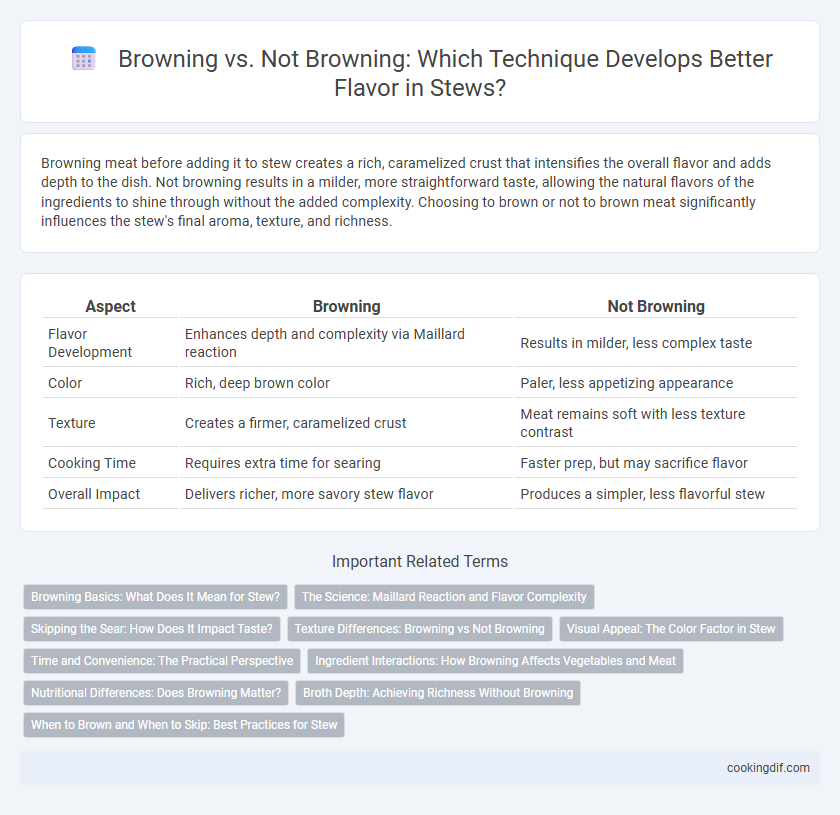Browning meat before adding it to stew creates a rich, caramelized crust that intensifies the overall flavor and adds depth to the dish. Not browning results in a milder, more straightforward taste, allowing the natural flavors of the ingredients to shine through without the added complexity. Choosing to brown or not to brown meat significantly influences the stew's final aroma, texture, and richness.
Table of Comparison
| Aspect | Browning | Not Browning |
|---|---|---|
| Flavor Development | Enhances depth and complexity via Maillard reaction | Results in milder, less complex taste |
| Color | Rich, deep brown color | Paler, less appetizing appearance |
| Texture | Creates a firmer, caramelized crust | Meat remains soft with less texture contrast |
| Cooking Time | Requires extra time for searing | Faster prep, but may sacrifice flavor |
| Overall Impact | Delivers richer, more savory stew flavor | Produces a simpler, less flavorful stew |
Browning Basics: What Does It Mean for Stew?
Browning in stew refers to the Maillard reaction, where proteins and sugars in meat develop complex flavors and a rich brown color when cooked at high heat. This process intensifies the stew's taste by creating savory, caramelized notes that deepen the overall flavor profile. Skipping browning results in a milder stew lacking the depth and aroma that contribute to a more satisfying eating experience.
The Science: Maillard Reaction and Flavor Complexity
Browning meat in stew triggers the Maillard reaction, a chemical process between amino acids and reducing sugars that creates complex flavor compounds and rich aromas. Not browning skips this crucial reaction, resulting in a stew with milder, less developed flavors. The Maillard reaction significantly enhances flavor complexity and depth, making browned stew more savory and satisfying.
Skipping the Sear: How Does It Impact Taste?
Skipping the sear when making a stew can result in a less complex flavor profile because browning meat triggers the Maillard reaction, which creates rich, savory compounds essential for deep, robust taste. Without the caramelization from browning, stews may taste flatter and less aromatic, lacking the toasted, umami notes that intensify the overall dish. Therefore, searing meat before simmering significantly enhances the flavor development in traditional stew recipes.
Texture Differences: Browning vs Not Browning
Browning stew ingredients creates a rich, caramelized crust that enhances texture by adding a crispy, slightly chewy layer, whereas not browning results in softer, more uniformly tender meat. The Maillard reaction during browning develops complex flavors and a firmer bite, contributing to a more satisfying mouthfeel. Stews without browning tend to have a smoother texture but lack the depth and contrast provided by the browned exterior.
Visual Appeal: The Color Factor in Stew
Browning meat before adding it to stew enhances visual appeal by creating a rich, deep brown color that signals robust flavor development. The Maillard reaction during browning produces complex pigments that contribute to a more appetizing appearance compared to stews made without browning, which often look paler and less inviting. This color factor not only improves presentation but also influences perception of taste, making browned stews more visually and gastronomically appealing.
Time and Convenience: The Practical Perspective
Browning stew meat enhances flavor through the Maillard reaction, which requires extra time and steps but creates a richer, more complex taste. Skipping browning saves preparation time and simplifies cooking, ideal for quick meals without compromising tenderness. Choosing between browning and not browning depends on prioritizing flavor depth versus convenience and cooking speed.
Ingredient Interactions: How Browning Affects Vegetables and Meat
Browning triggers the Maillard reaction, producing complex flavor compounds in meat and vegetables, enhancing umami and caramelized notes that elevate stew richness. In vegetables, browning caramelizes natural sugars, deepening sweetness and texture, while in meat it seals juices and creates a savory crust. Avoiding browning can result in a milder stew, lacking the depth imparted by these chemical ingredient interactions.
Nutritional Differences: Does Browning Matter?
Browning stew ingredients through the Maillard reaction enhances flavor complexity by creating rich, savory compounds but can slightly reduce certain heat-sensitive nutrients like vitamin C. Not browning preserves more antioxidants and water-soluble vitamins since lower heat exposure minimizes nutrient degradation. Although browning improves taste and aroma, it may marginally lower some nutritional values compared to cooking ingredients directly without browning.
Broth Depth: Achieving Richness Without Browning
Stewing without browning meat can yield a lighter, clearer broth that highlights the natural sweetness of vegetables and herbs while maintaining a clean flavor profile. The absence of Maillard reaction compounds results in a less intense, but delicately balanced broth, often preferred in traditional Jewish or Asian stews. This method emphasizes slow simmering and ingredient quality to develop complexity and depth without relying on caramelized crusts.
When to Brown and When to Skip: Best Practices for Stew
Browning meat before adding it to stew enhances Maillard reactions, creating deep, complex flavors and a rich color that elevates the dish. Skip browning when using delicate proteins or cooking low-and-slow with acidic ingredients like tomatoes, as extended simmering develops flavor without risking toughness or bitterness. For optimal stew, brown tougher cuts of meat quickly over high heat, then deglaze the pan to incorporate fond, while skipping this step for seafood or pre-cooked proteins to maintain texture.
Browning vs Not Browning for Developing Flavor Infographic

 cookingdif.com
cookingdif.com